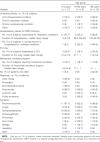Human metapneumovirus: a new player among respiratory viruses
- PMID: 15034830
- PMCID: PMC7107938
- DOI: 10.1086/382536
Human metapneumovirus: a new player among respiratory viruses
Abstract
The human metapneumovirus (hMPV) is a newly described member of the Paramyxoviridae family belonging to the Metapneumovirus genus. Since its initial description in 2001, hMPV has been reported in most parts of the world and isolated from the respiratory tract of subjects from all age groups. Despite the fact that prospective and case-control studies have been limited, the epidemiology and clinical manifestations associated with hMPV have been found to be reminiscent of those of the human respiratory syncytial virus, with most severe respiratory tract infections occurring in infants, elderly subjects, and immunocompromised hosts. Additional research is needed to define the pathogenesis of this viral infection and the host's specific immune response.
Figures





References
-
- Wright AL, Taussig LM, Ray CG, Harrison HR, Holberg CJ. The Tucson Children's Respiratory Study II: lower respiratory tract illness in the first year of life. Am J Epidemiol. 1989;129:1232–46. - PubMed
-
- Ruiz M, Ewig S, Marcos MA, et al. Etiology of community-acquired pneumonia: impact of age, comorbidity, and severity. Am J Respir Crit Care Med. 1999;160:397–405. - PubMed
-
- Davies HD, Matlow A, Petric M, Glazier R, Wang EE. Prospective comparative study of viral, bacterial and atypical organisms identified in pneumonia and bronchiolitis in hospitalized Canadian infants. Pediatr Infect Dis J. 1996;15:371–5. - PubMed
-
- Njenga MK, Lwamba HM, Seal BS. Metapneumoviruses in birds and humans. Virus Res. 2003;91:163–9. - PubMed
Publication types
MeSH terms
LinkOut - more resources
Full Text Sources
Other Literature Sources

